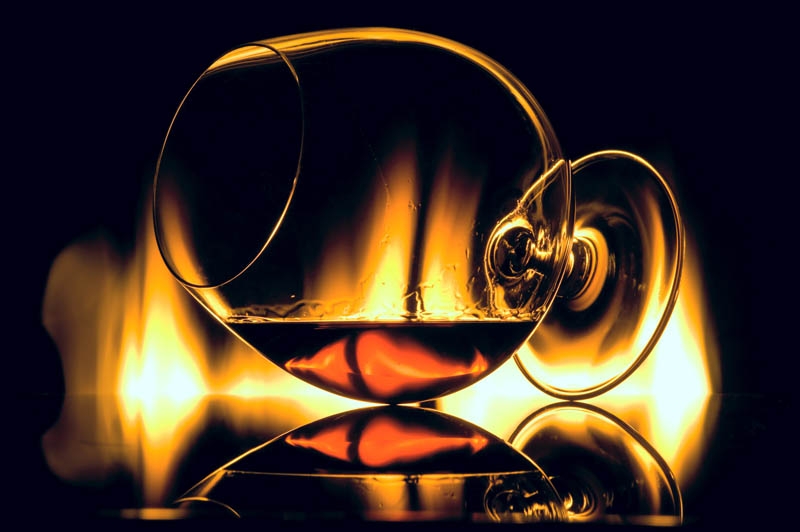
|

|

Cognac, also known as brandy, is an alcoholic drink distilled from grapes. It is manufactured in a way similar to wine and whisky except for the type of grapes it is made from. It was called cognac after Cognac city in the Charente department in southeastern France. In the rest of the world, it is called brandy.
History of cognac manufacture:
The manufacture of cognac dates back to the 16th century AD when Dutch residents came to the Charente department in France to buy salt, wood and wine. During their return journey, preserving wine was very difficult, so they started themselves to distil grapes only for once and turn it into what is called Eau de vie “Water of life.” However, with practice they found that distilling it again produced a better, smoother and more pleasurable drink. That was the birth of brandy “cognac”, whose name comes from the Dutch word Brandewijn, meaning “burnt wine.”
The manufacture of brandy spread all over the world. However, only the brandy made in France under strict conditions is called cognac (as we previously mentioned). Cognac spreads over two areas in France, the seaside Charente and the inland Charente. In both areas, there are six areas for producing cognac set forth in descending order according to aging and quality:
The type ofgrapes used in making cognac:
Cognac is made from certain types of grapes. Ugni blan grape is one of the most important types used. The following type can be also used, whether alone or mixed with Ugni blanc:
Colombard, Folle blanche, Folignan, Jurançon blanc, Meslier St. François, Select montils & Sémillon.
Before 1870, Ugni blanc was the main type used in cognac. However, after the plant pests catastrophe in 1870 that pervaded whole Europe, Folle blanche became the main type used due to its high pH and resistance of contamination. Until today, it is still the prevailing type in 90% of cognac.
Some commercial cognac types that do not have a specific name have more freedom to use other types of grapes in addition to mixing between them. The cognac made under strict condition uses Ugni blanc or Folle blanche grapes in a ratio of 90% and is mixed with another one of the mentioned types in 10% only.
Cognac manufacture method:
Fermentation and distillation:After pressing the grape, it is left two or three weeks to ferment, so that the sugar in it turns into alcohol. In this stage, nothing is added, and the alcohol percentage is 7-8%. After fermentation, the process of traditional distillation starts using a copper distillation machine, known as alembic, which is heated a little, and the distillation is carried out twice. In the first time, the upper part of the liquid, called the head, is vaporized, whereas the liquid in the bottom is called the pulp which contains 70% alcohol and is called “water of life”. In the second distillation, the alcohol is reduced to 60% and cognac is produced (when cognac is re-distilled, wine is produced).
Aging: When the distillation process is over, the resulting liquid is put in barrels made from oak wood that is found especially in Limozine and Trançois woods in France. It is then left to age for at least 2 years, then it can be sold after that period. During aging, an interaction between cognac and the oak wood barrels happens affecting the flavor. Thirty percent vaporization also happens as alcohol vaporizes and dissipates faster than water. The alcohol concentration decreases to about 40% over time increasing the quality and smooth taste of the drink.
Mixing and blending: Sometimes several distilled types of cognac are mixed together. The age of the cognac is then calculated according to the most recent component used in mixing. This mixing is important to complete the taste. Each type of cognac has a distinctive flavor according to its respective manufacturing company. Some manufacturers mix specific flavors, while others do not mix the final result, such as Guillon painturaud and Moyet, and this is similar to the production of single malt scotch.
Grades of cognac: According to the French Bureau national interprofessionnel du Cognac (BNIC), there are several grades that has a role in the official quality of cognac which are:
V.S (Very special): a three-star cognac aged for 3 to 5 years.
V.S.O.P (Very special old pale): Aged for 5 to 8 years.
X.O (Extra old): Aged for more than 8 years.
Hors d'âge: Similar to X.O but this term is used for high-quality products that are aged for a period exceeding the official aging period.
The names of grades are all in English because of the history of cognac trade especially in the 18th century to which the English contributed much. Cognac can may be named according to the geographical areas to which we previously referred: Grande champagne, Petite champagne, Borderies, Fins bois, Bon bois, Bois ordinaries.
Companies and types:
There are about 200 producer of cognac, 90% of which are in the US. The most important cognac products are: Courvoisier, Hennessey, Martell, Camus, Remy martin.
The best way to drink cognac:
Cognac is an alcoholic drink that is consumed without any additives, not even ice cubes. However, the best way to enjoy it is to warm the cognac bottle (especially XO and VSOP types) a little in front of the fireplace, then pour a small amount in the glass with lemon peel. As for Remy Martin, it is advised to drink it after putting a small piece of truffle chocolate in the glass.